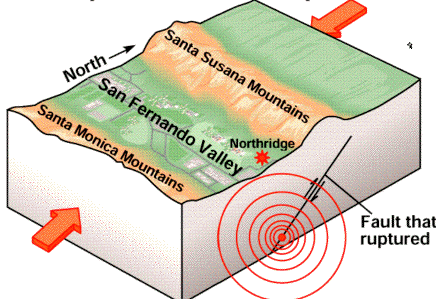
Earthquakes - the release of energy

Earthquakes - the release of energy
I hate "blinking text" but it did catch your attention. I am interested in finding out more about you and your backgrounds. Therefore, if you will complete the following Survey after November 1, 2001, you will earn 10 points.
 The link given above is an excellent introduction to seismology - the study of earthquakes - but it is quite large and you may want to set your browser to load the text first and then load each image on demand. To remain current, check out this well-produced, current report on Recent Earthquakes.
The link given above is an excellent introduction to seismology - the study of earthquakes - but it is quite large and you may want to set your browser to load the text first and then load each image on demand. To remain current, check out this well-produced, current report on Recent Earthquakes.
"When an earthquake fault ruptures, it causes two types of deformation: static; and dynamic. Static deformation is the permanent displacement of the ground due to the event. The earthquake cycle progresses from a fault that is not under stress, to a stressed fault as the plate tectonic motions driving the fault slowly proceed, to rupture during an earthquake and a newly-relaxed but deformed state."
This more detailed exposition should enhance your understanding of seismic waves. Think of these waves as a bundle of information. Techniques from the broad field of signal processing are applied to extract information about the processes that interacted to produce and modify the waves.
"What does an earthquake scientist think about late at night? Have I gleaned any useful insights from my dual roles as a researcher of faults and earthquakes in California and as a home owner living near the San Andreas fault about risk in general, knowing what I know? Is my experience of living in earthquake country similar to or different from yours?
This past week, you have probably thought more about earthquakes than you have in the last 4 years, since 5:04 PM on October 17, 1989, when the Loma Prieta earthquake rocked the Bay Area and, like a slap across the face, seized your attention. Maybe your fears, palpable then, have been reactivated now, and you have vowed, finally, to do something to protect your house and family."
Paul A. Reasenberg is a seismologist with the U.S. Geological Survey in Menlo Park, California. Regardless of where you live and what you have experienced, his essay is worth reading.
"In my eyes, there abides the face of a stricken man, perhaps a fireman, whom we saw carried into a lofty doorway in Union Square. His back had been broken, as the stretcher bore him past, out of a handsome, ashen young face, the dreadful darkening eyes looked right into mine. All the world was crashing about him, and he, a broken thing, with death awaiting him inside the granite portals, gazed upon the last woman of his race that he was to ever see. Jack, with tender hand, drew me away." - Mrs. Jack London.
Jack and Charmian London were at their ranch in Glen Ellen at the time of the earthquake, and soon left on horseback to see the ruins of the nearby California Home for the Care and Training of Feeble-Minded Children, as dust rose from the ruins.
Read several of these accounts and try to imagine what it would have been like to have experienced this large earthquake.
"In the northern part of Awajishima Island, it has been confirmed that an earthquake fault with large movement was formed. This fault, 9 km long, is a consequence of the movement of an existing fault known as the "Nojima Fault" which runs along west coast of Awajishima Island from the north end to middle."
Learning about geology from a computer screen is only half as fun as enjoying it in the field!
| jbutler@uh.edu
|E-mail the ClassListserv|Read the ClassListserv|
|Textbook Home Page
|Glossary of Geologic Terms|Search These Pages|
|Other Courses|Resources|Grade Book|
Copyright by John C. Butler, July 29, 1995